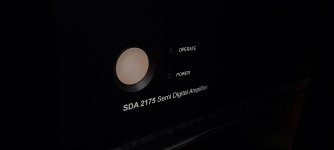Thanks, but sadly it doesn't make sense - at least not to me, a questioning "noise" cynic, who is eager to learn more about it!
First question is where does this "noise" come from? How it it generated and by what?
Second and most importantly, where in one's power supply does this noise enter? Is it at the power station a hundred miles away, or in the high voltage cable connecting the generator to you local sub-station, maybe 5 miles away, or from the low voltage cable from the sub-station to your fuse box, or between the fuse box and the wall socket behind your equipment rack, or the last few feet of the supply between the wall socket and the back of the amp or DAC?
If by some magical and fortunate coincidence it enters this long power supply chain after the wall socket (a totally incredibly situation), then perhaps a fancy last few feet of cable may help. Otherwise there's zero point in changing these last few feet unless you persuade your power supplier to upgrade the hundred miles or so from the power station, or wherever the "noise" enters the power supply chain.
Let's start by getting those basic and seemingly straight-forward questions answered in a convincing way before we take the next step in examining in a scientific way the question of this mysterious "noise" and how to get rid of it - if in fact it exists and needs to be got rid of.
Not trying to be difficult but simply asking the first questions such that I may understand your (and others) claims about the benefit of spending hundreds on a few feet of cable that is no part of the musical signal, but simply a voltage that allows the transistors, valves, etc to do their simple job of amplifying the incoming signal, or converting the digital stream to an analogue signal.
Thanks
I am glad you are asking these questions, which by no fault of yours show a fundamental lack of understanding of noise, and that is common:
1) "
First question is where does this "noise" come from? How it it generated and by what?"
Electronic noise is literally everywhere: it comes from the AM, FM airwaves; our WiFi routers; our own electronics of any kind that feed back noise into the same power lines, etc. If you were to look at a spectrum analyzer (never mind the basic Entech device and its ilk), you would see a power line littered with HF and UHF noise. Some of it is picked up because wires feeding our homes act as antennas, others as I said are generated by own electronics (for example, diodes in the equipment power supplies are themselves switching devices that generate noise, and some of it makes back out into the power lines). Collectively, this is the noise riding in the power lines, and again, some of it is picked up by the power company's power lines acting as antennas, some of it is generated inside our own homes and our own equipment, some of it by our neighbors'
2) "
Second and most importantly, where in one's power supply does this noise enter?" -
Beyond the antenna effect, electronic noise obviously enters our equipment at the start of the power supply inside our equipment, like a power transformer if we are talking about an analog power supply; similarly for switching power supplies. This is why power cords and conditioners go between the power lines and our equipment. Do not confuse "power supply" in our equipment with the power company's supply of power. Two distinct things. The Company supplies dirty power, and internally our equipment feature power supplies that convert AC from the lines into DC as best as possible, which in turn is then internally modulated to create sound. This internal modulation further includes switching devices like transistors, which inherently also generate noise which can then be fed back into the power line - there is no gain w/o pain. The better equipment the less internal noise it will generate and the less it will feed back.
Given all that, putting power cords and power conditioners between the Power Company's dirty power lines and the power supplies in our equipment CAN have an effect, sometimes positive (desired), others negative. The competent power treatment designs will help, the rest won't. Therefore, tread carefully as they say. Power cords and power conditioners are nothing more than filters between the power lines and the equipment power supplies, and consequently between our equipment as well. The Entech device, again, tells us (within its limited operating bandwidth) that there is at least AM noise riding on our power lines, and there is much more noise riding on them as well.
Noise is real and well-understood science and real physics, and in fact, it is a multi-faceted problem - there is nothing voodoo about it. And I will avoid talking about how quickly a power cord and conditioner can deliver current on demand to our equipment - another subject where Shunyata have shown with measurements they can probably outperform anyone else's offerings, especially those cheap cords that come packaged with our equipment.
Hope this helps
-ack

